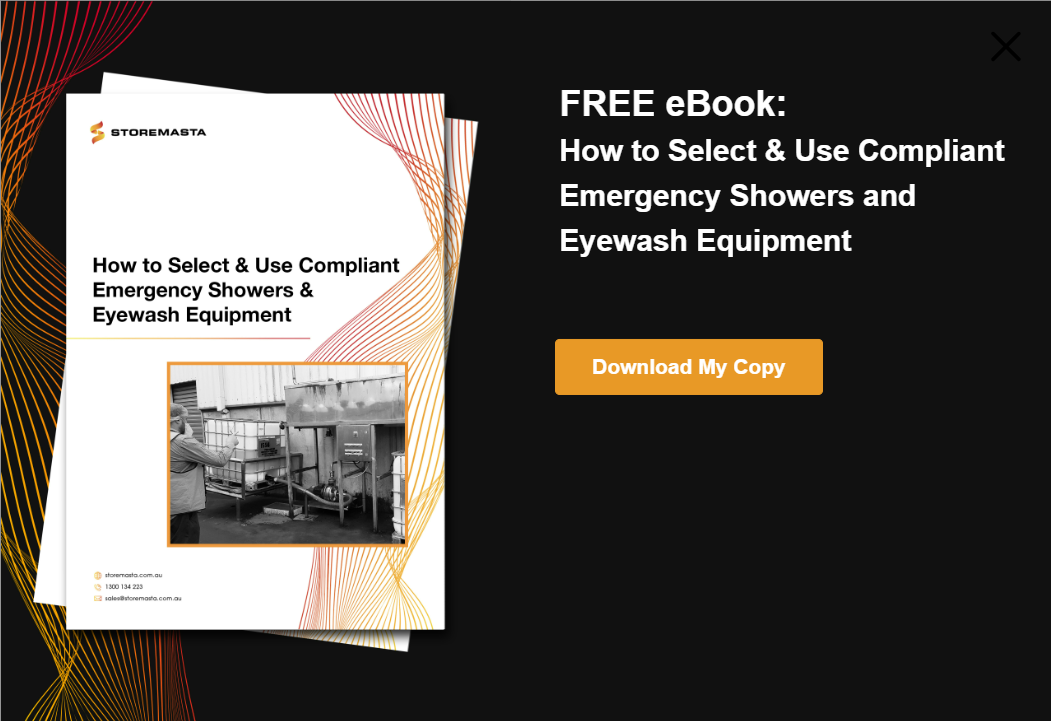Searching for the eyewash station requirements for different classes of dangerous goods? You’ve arrived at the right place. This blog details the eyewash requirements that relate to your dangerous goods package stores. While it can be a confusing issue trying to determine what emergency decontamination equipment is necessary for your site, you can take a methodical approach to this topic by first referring to the relevant Australian Standard.
Eyewash Station Standards
Each class of dangerous goods has an applicable Australian Standard that explains the handling and storage requirements for that chemical class. Within the Standard, there are specifics that relate to the provision, installation, location and maintenance of emergency decontamination facilities — such as an eyewash station.
REMEMBER: While the Australian Standards aren’t technically law, they allow organisations to get specific details about the compliant ways to handle and store hazardous chemicals and dangerous goods. Without adhering to the advice in the Standards, you may be putting your business at risk of chemical hazards, as well as facing a fine for non-compliance with the WHS Regulators in your state or territory.
What DG Classes May Require Eyewash Facilities
Due to the unique physical and chemical properties of each class of dangerous goods, each class of chemicals has specific requirements that relate to the installation of eyewash stations and/or safety showers.
The provision of eyewash facilities is particularly relevant when considering the storage of chemicals which could be easily splashed, sprayed or spilled into the eyes of staff who are handling them. In the next section of our blog, we’ll look at the specific requirements for eyewash facilities for each class of dangerous goods.
Eyewash Requirements For Storage Of Class 2 Gases
While you may not think of gases as posing a risk to the eyes of workers, if cylinders release gas unexpectedly, it may affect the eyesight of staff. Many Class 2 gases can impact human health. Some types of gases may corrode living tissue, causing permanent eye damage. Other gases may release toxic chemicals into the eyes and onto the skin of workers.
The eyewash station requirements for Class 2 Gases are found in the Australian Standard AS 4332:2004 – The storage and handling of gases in cylinders.
In Section 5.5 FIRST AID, the Standard explains:
5.5.2 Safety shower and eyewash facilities
Provision of a readily accessible safety shower (or ‘plunge bath’) and eyewash facilities, both complying with ANSI Z 358.1, should be considered, especially where corrosive or toxic gases or cryogenic or refrigerated fluids are handled.
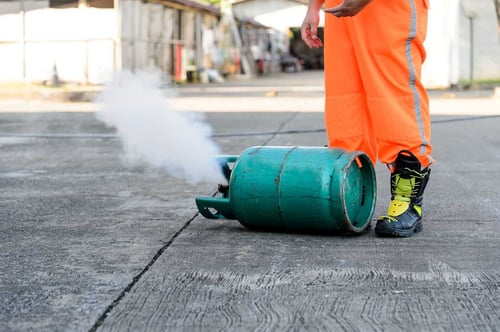
Gases can be sprayed into the eyes of your workers, so make sure you have the appropriate emergency decontamination facilities to reduce the risk of human harm.
IMPORTANT: If your chemical stores require both an eyewash station and a safety shower, you can install a combination model that offers an all-in-one emergency decontamination solution.
Class 3 Flammable Liquids
Flammable liquids must always be handled and stored in a way that reduces the risk of these volatile chemicals coming into contact with the staff that use them. AS 1940:2017 – The storage and handling of flammable and combustible liquids is the Standard for Class 3 Flammable Liquids.
The Standard explains in Section 4.6 that package stores must provide eyewash stations in the following circumstances:
The following items shall be provided within 10 m of, but not nearer than 2 m, to stores where packages are opened:
- Eyewash facilities complying with AS 4775.
- Water for the washing of hands.
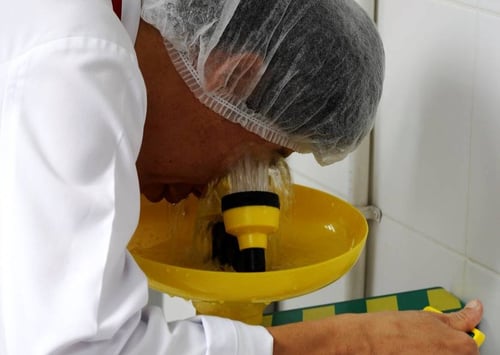
Flammable liquids can harm staff is they are splashed, sprayed or spilled onto skin or into the eyes.
IMPORTANT: While the Standard for flammable liquids stipulates that packages stores that are used for the opening of Class 3 packages must have compliant eyewash facilities, you should conduct your own risk assessment to determine if other flammable cabinets or stores would benefit from the installation of these emergency decontamination facilities.
Class 4 Flammable Solids
While flammable solids don’t pose the same spill risk that Class 3 liquids do, there are still some requirements that relate to the provision of first aid facilities in flammable solid stores.
Section 9.9 in AS/NZS 5026:2012 – The storage and handling of class 4 dangerous goods, explains that:
Facilities and response will be dependent on the nature of the substance, its quantity, and the location of the industry. An administrative procedure shall be in place to regularly review first aid advice as opinions on what constitutes an appropriate response may change.
Further requirements also apply — including the provision of compliant eyewash facilities where water-reactive substances are stored or used.
However, the hazards associated with water must be taken into account when choosing a location for eyewash facilities.
Class 5.1 Oxidizing Agents
Oxidizing agents are recognised as chemicals which can contribute to the combustion of other materials. However, these chemicals can also harm the people that are exposed to them. The adverse effects that these chemicals have on human health can include the corrosion of living tissue or toxic exposure through inhalation, ingestion or contact with the eyes or skin.
AS 4326:2008 – The storage and handling of oxidizing agents outlines the requirements for eyewash facilities in stores of Class 5.1 chemicals.
In Section 4.3, the Standard explains the requirements for packages stores of oxidizing agents. It goes on to say that:
For stores where packages are opened, eyewash facilities complying with AS 4775 shall be provided.
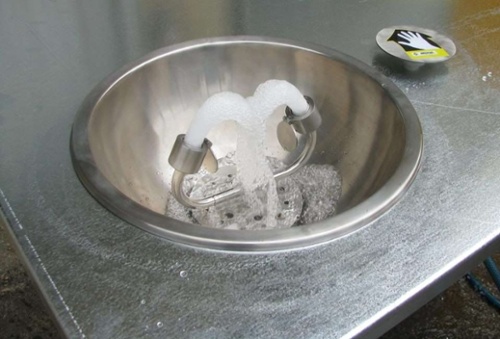
If you open packages of oxidizing agents in your package store, you must install an eyewash station.
Class 5.2 Organic Peroxides
One of the key safety hazards associated with the use of organic peroxides is their ability to damage the eyes of workers.
Therefore, the Standard AS 2714:2008 – The storage and handling of organic peroxides details the requirements that relate to the installation of eyewash facilities.
In Section 6.11 FIRST AID, the Standard states:
6.11.1 First aid station
A first aid station shall be provided in a clean area. It shall include a first aid kit, eye-wash facilities and a poster detailing the correct method of resuscitation. The first aid kit shall be kept fully stocked, with all items in a fit state of repair.
Class 6 Toxic Substances
Toxic chemicals, as we all know, are hazardous to human health. Whether they’re splashed into the eyes or unintentionally inhaled by workers, these chemicals can pose a wide range of serious health hazards. Extreme care must be taken by all staff who are responsible for the handling and storage of toxic substances.
The Standard that details the eyewash station requirements for toxic chemicals is AS/NZS 4452-1997.
In Section 4.4 GENERAL REQUIREMENTS FOR PACKAGE STORES, it explains that stores (other than indoor storage cabinets) must include the provision of emergency decontamination equipment. The Standard details these requirements:
The following items shall be provided within 7 m of, but not nearer than 2 m to, stores where packages are opened:
- A safety shower and eye-wash facilities, both complying with ANSI Z 358.1.
- Water for the washing of hands.
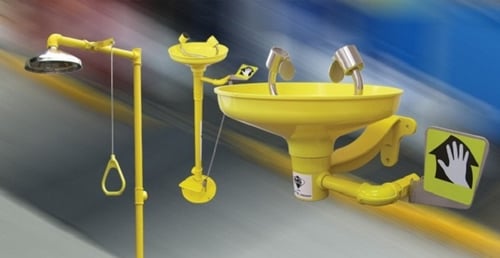
Toxic chemicals in packages stores require both eyewash facilities and a safety shower.
REMEMBER: While toxic substances must have an eyewash facility if packages are opened, this requirement does not apply to indoor chemical cabinets.
Class 8 Corrosive Substances
The Standard that details the eyewash station requirements for corrosives is AS 3780:2008 – The storage and handling of corrosive substances.
In Section 4.4 of the Standard, it explains emergency decontamination provisions for package stores where packages are opened:
Eye-wash facilities complying with AS 4775 must be provided within 10 m of, but not nearer than 2 m to, stores where packages are opened.
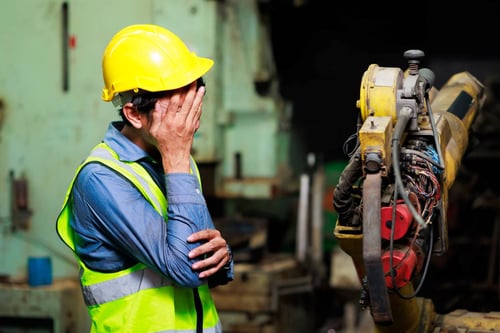
Corrosive substances will attack human tissue if they make contact with the eyes or skin of workers.
Class 9 Miscellaneous Dangerous Goods
Class 9 goods are a diverse range of dangerous goods which includes environmentally hazardous substances, elevated temperature substances and some specially controlled substances.
In Section 3.3 of AS/NZS 4681-2000, it explains the general emergency decontamination facility requirements for package stores of Class 9 goods:
3.3.5 Safety showers and eyewash facilities
The installation of a safety shower and an eyewash should be considered where packages are opened or goods are transferred.
NOTES: 1 Portable eyewash packs (minimum 250 mL) may be used instead of fixed eyewashes.
Like To Learn More About Eyewash Stations?
Remember, while these requirements are essential for packages stores, there are other circumstances which still may benefit from the installation of emergency decontamination facilities. If your workers are exposed to any hazardous materials that could adversely affect their health or safety, WHS Regulations states that first aid equipment must be supplied.
Would you like to learn more about the provision of eyewash stations and emergency decontamination facilities? We have an eBook that can help. How To Select and Use Compliant Emergency Showers and Eyewash Equipment offers further information about the legalities and Standards that apply to emergency decontamination equipment. It also lays out the key considerations you should make when selecting an eyewash station (or safety shower) for your workplace. Download your own copy of our guide today by clicking on the below image now.
Joining the team as a Dangerous Goods Storage Consultant, Melissa Hampton became Storemasta's Marketing Manager in late 2021. With extensive knowledge and experience in chemical compliance, Melissa is responsible for leading the Marketing team and helping shape their marketing strategy. In her spare time, you can find Melissa hiking, swimming and enjoying the great outdoors in beautiful north-west Tasmania.
